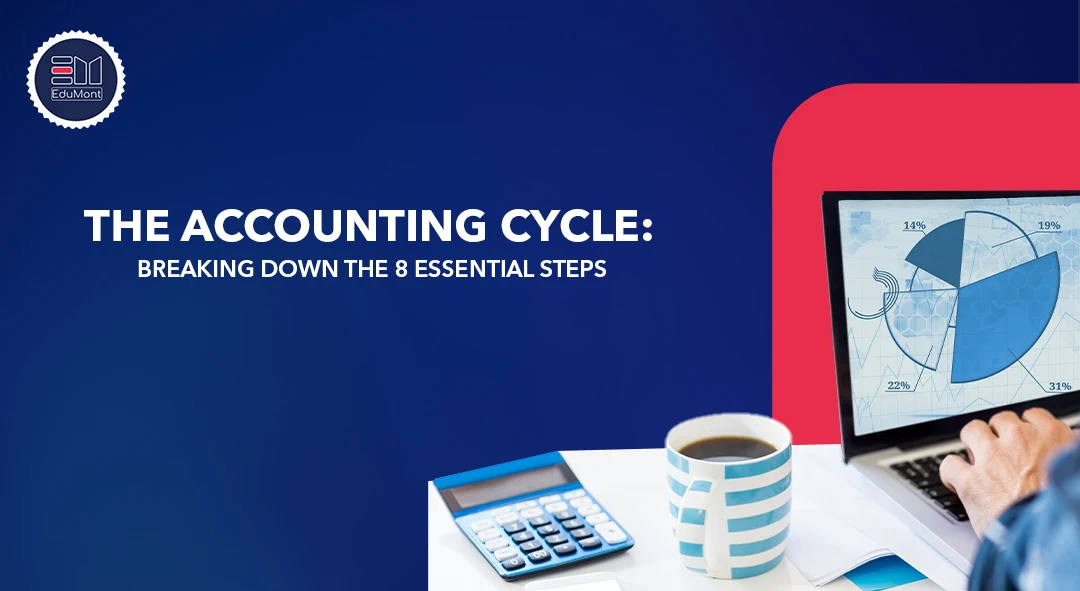“As long as the business is in business, the accounting cycle is in motion”
Rohan Chopra Sir
Understanding the accounting cycle is the first step in the finance world. Whether you are a CPA aspirant, CA aspirant or a B.Com student, these 8 essential steps of the accounting cycle provide you the right direction on how these businesses record, organize, and present their financial data.
Most people think accounting is about journal entries, but that actually is just the first step. This blog walks you through the 8 essential steps of the Accounting Cycle. From transactions in accounting to the entry of the general ledger to the final statements, everything has been covered and addressed thoroughly. Let us dive into it.
What is the Accounting Cycle?
The accounting cycle is a step-by-step process that ensures accurate recording and reporting of financial data over a given accounting period. It helps businesses make informed decisions and maintain compliance.
By the end of this cycle, organizations are equipped with clean, structured data to prepare their financial statements.
Step 1: Identifying and Analyzing Transactions
The journey of the cycle begins when a business identifies transactions that have a financial impact. This includes purchases, sales, payments, and receipts.
Once identified, the transaction is analyzed to determine which accounts it affects and whether it increases or decreases them.
Example: A company pays rent — this reduces cash and increases rent expense.
Step 2: Recording Journal Entries
In this step, transactions are documented using journal entries in a chronological journal. Each entry includes a date, accounts impacted, amounts, and a brief description. When you pass an entry, you need to be well-versed with the “Golden Rules of Accounting”. However, you can skip the “Golden Rule” with an easy trick, watch the youtube video to know more.
This step is the first formal record in the accounting cycle and uses the double-entry bookkeeping system (debit and credit).
Step 3: Posting to the General Ledger
After journal entries are recorded, they are transferred or updated to the general ledger.
The general ledger categorizes transactions into individual accounts — like Cash, Sales, Inventory, and Utilities — giving a clearer picture of each account’s activity over time.
Step 4: Preparing the Unadjusted Trial Balance
Once transactions are posted, an unadjusted trial balance is prepared. This report lists all accounts and their balances to check if total debits equal total credits.
This step helps spot any immediate recording errors before adjustments are made.
Step 5: Preparing Adjusting Entries
Not all financial activity is captured through regular transactions. This requires past adjusting the JE’s because accruals, deferrals or errors need to be adjusted.
This step ensures that financial records comply with the matching principle — expenses are matched with related revenues in the correct period.
Step 6: Preparing the Adjusted Trial Balance
After making adjusting entries, a new trial balance — called the adjusted trial balance — is prepared.
This updated report reflects the company’s financial state more accurately and is the final source for preparing financial statements.
EduMont Tip: Students often confuse the trial balances. We break this down visually in our video tutorials for better retention.
Step 7: Preparing Financial Statements (Income Statement, Balance Sheet, Cash Flow)
With clean data now available, the core financial statements are created:
- Income Statement: Shows profit or loss over a period
- Balance Sheet: Summarizes assets, liabilities, and equity
- Cash Flow Statement: Tracks inflow and outflow of cash
Together, these statements give stakeholders insight into the company’s financial performance and health.
Understanding how to prepare and analyze these statements is a key part of EduMont’s accounting curriculum.
Step 8: Closing Entries / Closing the Books
At the end of the accounting period, temporary accounts (revenues, expenses, dividends) are closed to the retained earnings account. This resets them to zero for the next period.
This step marks the end of the current accounting cycle and the beginning of the next.
Example: Revenue of ₹10,00,000 would be transferred to Retained Earnings, and the Revenue account reset to ₹0.
Why the Accounting Cycle Matters
The main idea behind the accounting cycle is to maintain proper consistency, accuracy and transparency in major and minor financial reports.Transforming daily transactions into meaningful reports is crucial for investors, management, auditors and regulators.
For students and future CPAs, understanding how the accounting cycle works is foundational. That’s why our experts don’t just teach theory — they simulate the real-world application with guided mentorship and case-based learning.
Real Accounting Cycle Example
Let’s say a company buys office equipment for ₹25,000 in cash:
- Step 1: Identify – equipment purchase
- Step 2: Journal Entry – Debit Equipment, Credit Cash
- Step 3: Post to ledger
- …all the way to Step 8
This example is simple, but the process stays the same even in large enterprises.
Closing Remarks
The accounting cycle is an imperative process and it keeps on moving. It is the most basic yet most important step in every business in motion. Whether you are an undergrad, a CPA aspirant or preparing for CA, mastering the accounting cycle is a must.
And with EduMont Classes, you gain access to expert faculty, guided practice, and concept clarity that ensures you’re exam- and industry-ready. Reach out to us with your queries at support@edumontclasses.com








